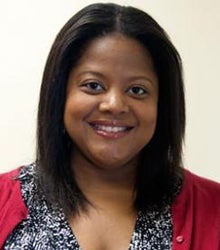
Daisy-O'lice Williams
Master of Architectue, Florida Agricultural and Mechanical University, 2005
Bachelor of Science in Architectural Studies, Florida Agricultural and Mechanical University, 2002
Daisy-O’lice I. Williams is an Associate Professor in the Department of Architecture. Over the course of her career, she has taught design communication, architectural theory, and design studio at the beginning and graduate levels. Williams specializes in architectural visualization and teaches in the program’s media curriculum in addition to coordinating first year studios. Her research and teaching is driven by the underlying assumption that what we use to design influences what we are able to design. She is particularly interested in modes of communication that directly engage the human experience.
Through her teaching she provides learning spaces where conventional and unconventional methods of representation are considered for their value as tools for thinking and narrative creation. Recent investigations include the role of digital collage in the student design process and the viability of augmented reality as a collaging medium. She has presented research on design media at the National Conference on the Beginning Design Student, Environmental Design Research Association Conference, the Association of Collegiate Schools of Architecture Annual Meeting, and the Design Communication Association European Conference.
Williams is committed to investigating and increasing African-American presence and participation in architectural education. Her work on strategies for increasing diversity awareness among student populations has been published as the coauthored chapter “Race and Gender in Architecture: A Distance Learning Model” in the book, Spaces Unveiled: Invisible Cultures in the Design Studio. Her research on the early history of architectural education at Historically Black Colleges and Universities will be included as a chapter in a forthcoming book on architectural education in the United States. Williams has also participated in two NEH Summer Institutes to support research on a digital humanities project entitled Freedom’s Fortress. The project’s goal is a virtual re-creation of the social and physical setting of 1860s Fort Monroe and nearby Phoebus (downtown Hampton, Virginia) where nearly 10,000 enslaved people sought refuge as “contrabands of war”.
Additionally, Williams writes about the professional practice of architect Paul R. Williams, the first African-American member of the AIA and one of California’s most prolific architects. She collaborated with colleagues to create the PRW Career Mapper, a web-based research tool for visualizing the distribution of his work over the span of his career (www.prw.uoregon.edu). Research outcomes were presented at the Society of Architectural Historians Annual Conference, California College of Arts Association, and the NOMA National Conference on this topic.
Prior to joining the faculty at UO, Williams worked as an Assistant Professor for the Department of Architecture at Hampton University where she was recipient of the Hampton University Provost Innovative Teaching Award in 2007.
